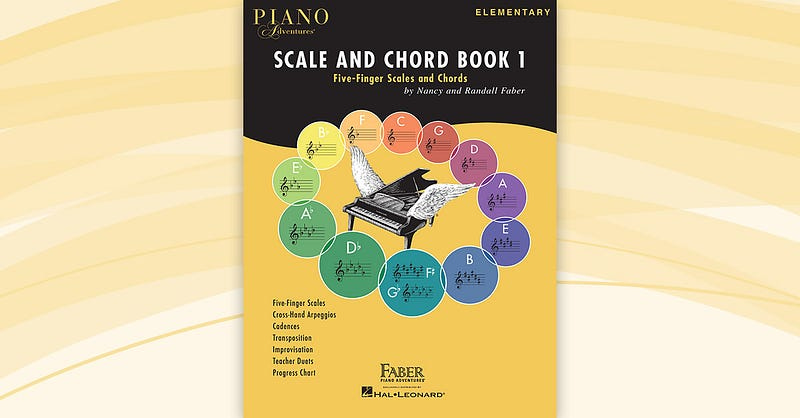My most-used elementary improvisation book might surprise you!
On the face of it, it looks like an odd choice.
It’s a relatively obscure elementary-level publication from Nancy & Randall Faber’s sprawling Piano Adventures series called “Scales and Chords Book 1: Five Finger Scales and Chords”. Improvisation is mentioned on the cover just once, near the bottom of a list of topics covered. So why this book? (And why have I not chosen one of Forrest Kinney’s wonderful books?)
One of the reasons I find this book is so useful is because improvisation is introduced so casually: it’s presented as a thing that you automatically do when you’re learning to play the piano. This normalises creativity, which is fundamental to build their confidence.
That differentiates it from most creativity resources, including Forrest Kinney’s Pattern Play series, which I love and use all the time. There the improvisation is the focus, which some students find intimidating. Here creativity is included almost by stealth! If students react well to the improvising in the book (and most do) then I’ll switch to a more overtly creative resource.
Using the first exercise as an example: first the student plays the C major pentascale (5-note scale) loudly, then quietly, then staccato, then they improvise with prompts saying that it should sound like a “happy march” and that they should include some repeated and staccato notes. The teacher accompanies throughout, so the student doesn’t feel exposed when improvising. I’ve used this with many students and it works brilliantly because it’s fun and accessible.
The other thing that makes this book so useful is that it has short simple accompaniments for improvisations in all 24 major and minor keys. The accompaniments are very varied, with nods to classical, jazz and contemporary genres. That means you can use it to introduce your student to many keys and many styles: it’s a great resource for getting started. Here’s a video showing the first four accompaniments in C, G, D and A major.
That makes the book useful for not just the young beginner you might picture when you read the word “elementary” on the cover. I’ve also used it to great effect with intermediate level adult who want a very simple introduction to improvising in many styles.
What’s your go-to elementary improvisation resource? Do you prefer one of Forrest Kinney’s books, or Alice Kay Kanack’s? Have I missed something? Get in touch at hello@pianocreativity.com!




